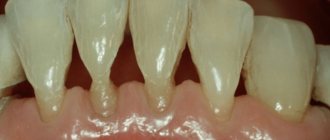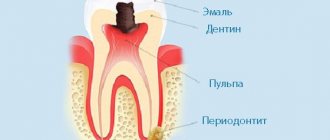Content:
- Causes
- How does pathology manifest itself?
- How is the treatment carried out?
- Surgical techniques
- Additional treatments
- Preventive measures
If the gums have become detached from a wisdom tooth or any other unit, you need to visit a doctor as soon as possible.
When the soft tissues subside, the neck remains unprotected and exposed. It is not covered with a thick layer of enamel, so it immediately begins to react sharply to temperature changes. The situation is aggravated by the fact that food debris gets into the formed periodontal pocket. They accumulate there and serve as an ideal breeding ground for pathogens. If such a pocket is not cleaned in a timely manner, it will increase in size. Then it will come to edentia.
Possible complications
Most often, the situation makes patients worry, and they ask what to do if the gums between the teeth droop down, how to restore it? These are true questions to which the doctors at the Dentika clinic are always ready to give competent answers. However, it happens that people do not go to the dentist, preferring to think that the prolapse of soft tissue is just a small cosmetic defect. This is not true: if the disease is started, it, together with the causes of the pathology, can lead to serious consequences:
- lymphadenitis - a condition in which the lymph nodes (usually in the neck) become inflamed;
- periostitis - inflammation of the periosteum;
- periodontitis;
- infectious lesion of the bone of the jaw apparatus.
Causes
Exposed necks indicate periodontal damage. Most often the problem occurs for the following reasons:
- Genetic predisposition. When exposed to this factor, a person can very diligently monitor the health of his smile, but will still periodically encounter unpleasant dental symptoms.
- Mechanical and thermal damage. The habit of gnawing on foreign objects, eating too hot food, using a hard brush are all provocateurs that contribute to irritation.
- Poor oral hygiene. If the patient neglects basic hygiene rules, a lot of plaque is deposited on the crowns. Pathogenic microorganisms spread in it. The gums become irritated, turn red, and bleed. Gradually they begin to move away from the teeth. It is important to use a brush and paste twice a day, and undergo professional hygiene at the dentist’s office annually.
- Poorly performed prosthetics or mistakes made during filling. It is necessary that the dentures fit as tightly as possible to the bases and do not fall under pressure, otherwise the gums will be constantly injured and inflamed.
- Curvature of the bite, problems with teething “eights”, uneven edges of the crowns. All this causes the gums to move away from the tooth.
- Unbalanced diet. If a person eats only soft foods and sweets, he does not actively chew food. As a result, blood circulation in the oral tissues slows down, less saliva is released, and periodontal deposits are actively formed. These are the prerequisites for a recession.
- A large amount of tartar. Despite the fact that dentists recommend removing stones annually or even more often, many patients do this very rarely. You shouldn't wait until a serious problem arises. It is easier and cheaper to prevent it than to treat it later.
- Hormonal imbalance. Most often, this reason concerns women, for example, during pregnancy, menopause, and breastfeeding. With hormonal fluctuations, the mucous membranes become especially vulnerable. Even minor mechanical impacts cause recession.
Don't forget about the negative effects of tobacco smoke. According to statistics, smokers are much more likely to suffer from gum disease and exposed necks. They accumulate plaque faster. Therefore, if you want to have a healthy smile and visit the dentist less often, stop smoking.
Diseases in which the gums recede from the teeth
There are a number of somatic disorders that are risk factors - in their presence, loss of soft tissue occurs more often and progresses faster than in healthy people. Recession is a common occurrence in patients suffering from:
- diabetes mellitus of any type;
- problems with the kidneys, liver, spinal cord (they can cause circulatory dysfunction in the soft tissues of the oral cavity, as a result of which they do not receive sufficient oxygen and nutrients);
- diseases that are accompanied by immunodeficiency states;
- endocrinological pathologies (disruption of the endocrine glands).
Too frequent and prolonged use of diuretics, prescribed for some diseases, also contributes to the manifestation of the anomaly, since essential nutrients are removed from the body along with the fluid.
Below is a list of dental disorders in which the development of recession, when a piece of gum comes off near the tooth, can be most likely predicted:
- periodontitis - inflammation of the periodontium, which is characterized by destruction of the normal structure of the alveolar process;
- gingivitis - irritation of soft tissues without compromising the integrity of the periodontal junction;
- neoplasms of various etiologies.
How does pathology manifest itself?
Symptoms depend on how far the gum has receded from the tooth. Most often patients complain of:
- increased bleeding and soreness of the gums;
- bad breath that cannot be eliminated with standard hygiene products;
- taste of pus;
- separation of purulent masses from the inflammatory focus;
- the appearance of deep periodontal pockets;
- loosening of individual units.
In the first days of the disease, patients may not experience any significant discomfort. They are just beginning to notice that in certain areas of the jaw the tissue seems to have sagged and become less voluminous. Because of this, the crown part of the tooth, on the contrary, looks elongated.
If the gums have peeled off, there is no need to try to do anything on your own. Without qualified help, it will still not be possible to cope with the recession. Postponing competent therapy until later is fraught with even more serious violations.
How is the treatment carried out?
Some people think that they can be cured with regular rinses. Unfortunately, it is not. The first step is to make an appointment with a dental hygienist. The doctor removes soft and hard deposits from the surface of the crowns and subgingival area in one session.
The following methods are used to remove stone:
- Instrumental. Involves the use of special scrapers that remove deposits. It is considered outdated and is extremely rarely used by doctors, as it is traumatic.
- Ultrasonic. Using an ultrasonic scaler, the doctor crushes the stones into tiny particles. This equipment produces waves of the required frequency, which easily destroy dental plaque.
- Sandblasting. It is the most modern and safe. The doctor delivers the cleaning solution under high pressure. Abrasive particles wash away deposits from crowns and effectively flush out existing pockets. The advantage of the technique is to achieve the effect of teeth whitening by one or two shades.
If the hygiene procedure does not help and the problem is serious, the patient is prescribed surgical treatment.
Diagnostics
Only a dentist can determine the exact cause of periodontal tissue recession and prescribe appropriate treatment.
At the appointment with this specialist, a visual examination of the oral cavity will be carried out and a modern diagnostic examination will be prescribed.
For these purposes, patients are prescribed:
- Radiography.
- Orthopantomogram.
- Measuring the depth of the periodontal pocket.
Important! To accurately determine the etiology of the disease, the dentist may prescribe additional examination to exclude provoking systemic pathologies. This will make it possible to carry out complex therapy and achieve rapid recovery dynamics, eliminating the development of relapse.
Surgical techniques
In advanced situations, plaque removal alone is not enough. Then there may be a need for open or closed curettage. It is indicated if the gums are very severely detached from the dental neck and the bone structure is changed.
The dentist-surgeon treats the lesion with an antiseptic, makes a small incision and removes purulent deposits and affected tissue . Then the gum is sutured. All manipulations are performed under local anesthesia. This means that the patient is conscious and can communicate with the doctor, but does not feel pain.
For a speedy recovery after curettage, antibiotics and mouth rinsing with an anti-inflammatory solution are prescribed. If the pain after surgery is very severe, the patient can use painkillers.
When do you need to see a dentist urgently?
Contacting a dentist is required in the following cases.
- Pericoronitis
– the “hood” will be excised. - The figure eight puts pressure on neighboring teeth
- it needs to be removed. - Initial caries
– treatment will be carried out. - Medium, deep caries or rotten tooth
- a clear removal of the figure eight. - The wisdom tooth is loose
- a diagnosis of its condition will be carried out, according to the results of which the molar will be treated or removed. - Pulpitis
– if the root canals are passable, they will be filled.
This list should also include the above symptoms of pathological teething - pain when opening the mouth, swallowing, high temperature. If they appear, you should contact your dentist immediately, since this is a serious inflammatory process, the localization of which requires adequate treatment.
The reason for contacting a specialist may also be the “normal behavior” of the number eight. In this case, the doctor will simply make a small incision on the gum, thereby facilitating the eruption of the wisdom tooth. After a simple procedure, the process will be less painful, and the incision site will heal quickly, after pain for 2 to 4 days.
Additional treatments
Considering that gums become inflamed for various reasons, it is important to try to find out the provoking factor. Then the risk of relapse of dental pathology can be reduced to a minimum.
If the doctor determines that the disorder is related to hormonal levels, it is necessary to select hormonal therapy . In case of malocclusion, consultation with an orthodontist is indicated. If the diet is unbalanced, the patient is told what the diet should be like after recovery.
Often, when fighting gum that has receded from a tooth, anti-inflammatory drugs, immunomodulators, glucocorticosteroids, and antiseptics are used. It is very important that the patient strictly follows all medical prescriptions and does not engage in amateur activities. An integrated and responsible approach to treating recession is a guarantee of a speedy recovery.
If the tissues become so inflamed that the teeth begin to loosen, splinting may be required. If there is a deficiency of bone tissue, their deficiency is compensated with special compounds.
Forecast
With apical displacement of the gingival margin, in most cases the prognosis is positive.
Timely and adequate therapy allows you to restore the structure and integrity of periodontal tissues. This helps prevent the destruction of periodontal tissues and tooth decay.
Gum recession requires mandatory treatment. It is strictly not recommended to ignore it. Advanced stages of pathology contribute to the rapid development of complications and partial or complete loss of teeth.
Preventive measures
To prevent gums from moving away from the tooth, you need to follow simple recommendations:
- brush your teeth twice a day;
- use a properly selected brush and paste;
- visit the dentist in a timely manner;
- prevent tartar from forming;
- no smoking;
- eat more solid foods;
- Healthy food.
At the first sign of a recession, you should see a doctor. Then the disease can be stopped very quickly.
First aid at home - what to do if gums recede and teeth are exposed
It is unacceptable to refuse to visit the clinic, since in this case the pathological process will continue - it will not be possible to fully recover without a doctor. However, if it is not possible to make an appointment with a doctor immediately when an anomaly is detected, you can slightly delay its progression:
- use only soft toothbrushes and floss;
- Irrigate the oral cavity several times a day with dental (local) antiseptic solutions to prevent the development of severe inflammation;
- use antibacterial gels;
- rinse your mouth with anti-inflammatory herbal teas (chamomile, sage, propolis, etc.) or use them as short-term compresses.
It is better not to disturb the painful area, clean very carefully and do not injure the tissue with hard objects (in particular, avoid hard snacks like seeds, chips or crackers).










